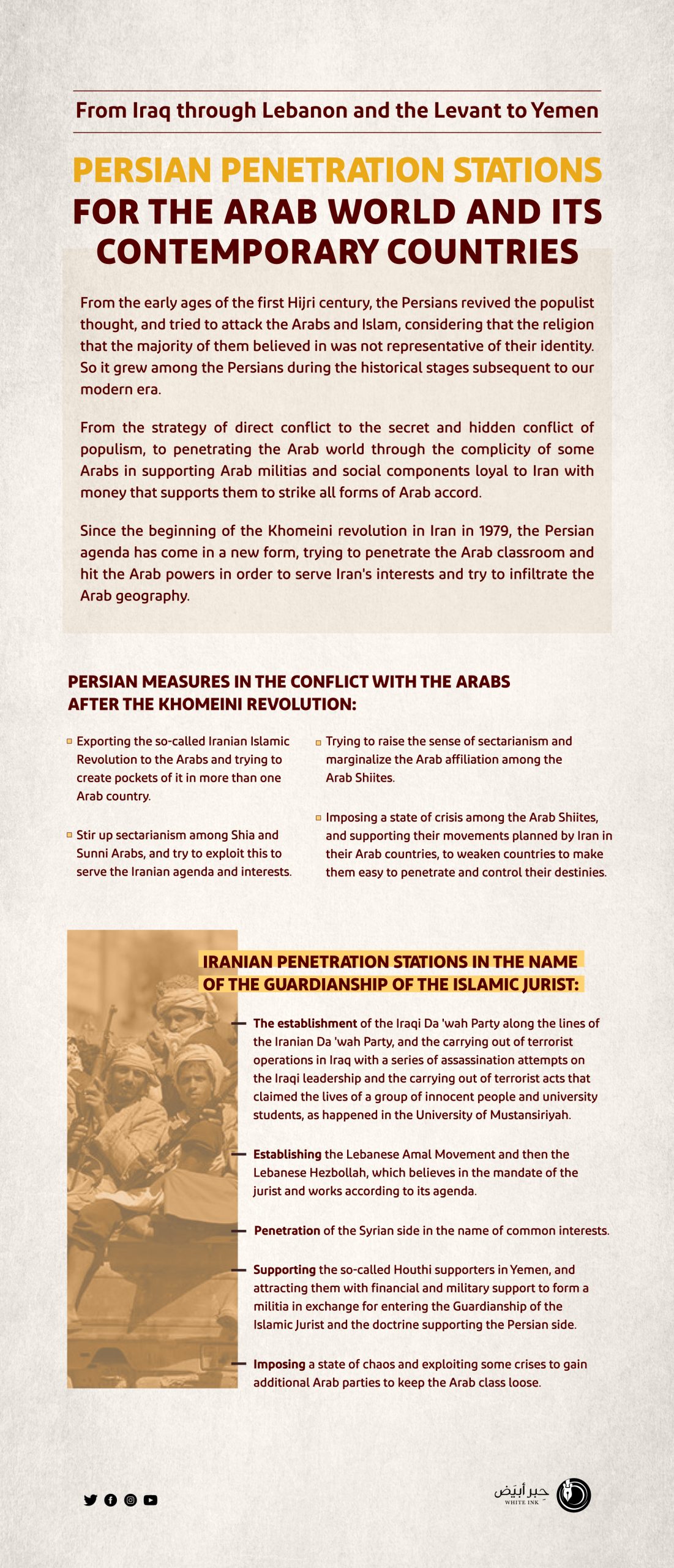
Starting from the first Hijri century,
The Persians’ way to striking Arab identity is through “The Shu’ubiyyah”.
After the Persians failed militarily to face the Muslim Arabs in previous historical stages, they took another approach through a new ideology that was deepened by the Shu’ubis movement, which represents one of the factions of the plot against the Muslim Arabs. The Shu’ubiyyah deliberately attacked the Arabs, who carried the banner of Islam and the owners of the Islamic state, in their history, way of living, Islamic history, the Arabic language, and the origins and roots of Islamic values. The Shu’ubiyyah deliberately also broadcasts promiscuity and deviation considering this a kind of liberation.
The Shu’ubiyyah is an ancient movement as old as the relationship between the Arabs and their non-Arab neighbors on their frontiers in Persia, Anatolia, and the peoples who settled in the Levant and North Africa. The relationship between the Persians and the Arabs of the island before the emersion of Islam confirms this. Khosro’s detracting description of the Arabs before al-Numan Ibn al-Mundhir, the king of the Ghassanids, clearly indicates this.
The Shu’ubiyyah is not -as the Shu’ubis claim- a later reaction that appeared in the first Hijri century as a result of Arab actions following the establishment of the Umayyad state in the Levant, Iraq, and Persia, then Andalusia in the west and China in the east. In fact, it was a grudge against the Arabs from whom the message of Islam emerged, and they carried it to the world. Rather, its consolidation expanded in the foreign conscience and the literature of the second Hijri century, after the Persians seized the pillars of the state following the coup of the Caliph al-Ma’mun against his brother Al-Amin with the help and support of the Persians.
In a research published in Al-Azhar University Journal, Human Sciences Series by researcher Othman Muhammad Al-Abadla, it was stated that the emergence of the Shu’ubiyyah was observed early in the Umayyad era, and Arabic poetry was a reservoir of preservation for that abnormal tendency that is continuous till this day due to the inheritance of hostility against Arabs. The Shu’ubiyyah appeared in Poetry early, firstly by one of the poets of the Umayyad era, Ismail bin Yasar al-Nasa’i, who was proud of his people and their glories and cursed the Arabs for their ignorance, their customs, and their way of living. However, the political and social conditions would not have allowed this tendency to be broad and comprehensive and to transform into a trend that has its audience and supporters. They had to wait for the right opportunity to change the political situation.
Al-Abadla states, “It seems that the name Shu’ubiyyah did not appear until the first Abbasid era, because the owners of this tendency, which tries to equalize or degrade the Arabs, did not take a strong and clear form that could be called by a name for its adherents except in this era. Before that, it was a hidden tendency that could not appear, and if it appeared, it would be suppressed. The need for a name is only after the principle has taken the form of a general creed or a party. Also, this name was not given to this tendency in the Umayyad era. The oldest of the books that have come down to us using the term Shu’ubiyyah is the book “Al-Bayan wa Al-Tabyin” by Al-Jahiz. Moreover, Al-Jahiz addressed it in many of his books.
And from what the Persian poet Al-Nisa’i said, exposing the hatred and malice of his Shu’ubis approach against the Arab race:

Al-Nisa’i continued his pride with his Persian people over the Arabs in another poem he said in the presence of the Umayyad Caliph Hisham Ibn Abd al-Malik, who did not harm him which confirms the false claim of the Shu’ubis about the Arabs’ hatred for them. All that the Caliph did was to remove him from his assembly. Al-Nisa’i said:

Hatred of the Arabs and Islam:
The Shu’ubis have come to hate the religion of Islam that the Arabs carried to the world after the Persians worshiped fire, the devil, and the stars. Rather, they worked to kidnap it and introduce defunct beliefs and superstitions into it after they despaired of bringing it down. The Arab writer Al-Jahiz depicts the Shu’ubis movement and its goals by saying:
The impact of Shu’ubiyyah in Arab societies:
There is no doubt that a major civilizational shock occurred for the non-Arabs after the establishment of the Arab empire. The Persians -in particular- did not think that the Arabs would stand up while they live in those barren deserts without resources, capabilities, or heritage to rely on. The contempt and the inferior look precipitated the relationship and pushed the Persians to believe in their racial superiority over the Arabs, and they described them in many of their poems and books as thieves and lizard eaters. Al-Jahiz said:
Islam shocked them with its civility, values, morals, and honors. It pushed their ancient empires to collapse in front of its great prestige and values, but that did not push them to surrender. So, their entrance to the robbery of the status of Islam was to claim the wrongdoing of false racism, and this is repeated in every era, which led them to establish a counter movement under the description of the Shu’ubiyyah, then attack the Arab state penetrating up the administrative ladder until the domination of the Caliph the head of the state occurs, which is exactly what happened in the Abbasid era.
The Shu’ubiyyah roots:
Many researchers are not satisfied with returning Shu’ubiyyah to the Abbasid era or the emergence of its cues in the Umayyad era. Rather, they trace its roots back to the incident of Abu Lulu’a al-Majusi’s assassination of Caliph Omar Ibn al-Khattab, may Allah be pleased with him. This Persian did not accept the fall of Iwan Khosrau and the defeat of his nation in front of the Arabs of the Arabian Island, his goal was not only revenge but the destruction of the Arab Muslim state in its own backyard and the assassination of its leader.
The researcher Tamim Al-Younis confirms in his published book that the assassination of Caliph Omar Ibn Al-Khattab was the first hostile act of the Shu’ubis movement in retaliation for the Samanid state that was subjugated during his era. In his research, he draws attention to the marriage of the Shu’ubiyyah of the Jews with the Shu’ubiyyah of the Persians at the beginning of Islam, which was pioneered by the Yemeni Jewish Abdullah bin Saba, which later resulted in alliances with foreign powers hostile to Islam and Muslims, such as the alliance of al-Tusi and Ibn al-Alqami with Hulagu and the Mongols.
The Persian Shu’ubis were openly racist in front of the Arab caliphs.

The support of the powerful forces in the Arab state:
The danger of the Shu’ubiyyah lies in its transformation from a counter-cultural movement to a kind of “secret party” that worked within the Abbasid Arab state to demolish it. Persian prime ministers, senior officials, and even writers and poets of foreign races became involved in that movement, and their only concern became revenge against the Arabs, degrading them, overthrowing their historical status, and the demolition of their state, which is what Reda Jameh sees in his book, The Phenomenon of Shu’ubiyyah in the Abbasid Era.


- Anwar Al-Sadiq, Effects of the Shu’ubis Movement and Heresy on Intellectual Life in the First Abbasid Era 132-266 Hijri, Master’s Thesis, Al-Fateh University, Libya (2006).
- Reda Rafe, “The phenomenon of Shu’ubiyyah in the Abbasid era”, Al Modawana Magazine, Center for Literary and Critical Studies, University of Medea, Algeria (2015).
- Abdulaziz Al-Douri, The Historical Roots of The Shu’ubiyyah, 3rd Edition (Beirut: Dar Al-Tali’a, 1981).
- Othman Al-Abadla, “The Shu’ubiyyah in Arabic Poetry: Its Objectives and Origin,” Al-Azhar University Journal, Humanities, Volume 3, Issue1 (2000).
- Noura Al-Duwaiher, “Historical Dimensions of Persians’ Hostility to the Arabs from the Emergence of Islam until the End of the Second Abbasid Era 334 Hijri”, Journal of the GCC Society for History and Archeology, Issue. 14 (2019).
- Al-Jahiz, “The Animal”, Dar al-Kotob al-Ilmiyah, Beirut, second edition, 1424 Hijri.


The Guardianship of the Islamic Jurist (velayat-e faqih)
An attempt to obliterate the identity of the Arab Shiites and turn them into a hybrid of the ancient Persian culture
The specialist and observer of the Middle East’s history is aware of the reality of the hostile tendency that controls the political powers in the Iranian plateau towards the eastern Mediterranean and the Arabian Peninsula. The method of hostility increased after what they called the Islamic Revolution in Iran (1979) and Khomeini’s control of the political leadership. This was after imposing the principle of The Guardianship of the Islamic Jurist (velayat-e faqih), and then this ideological political system covered its political ambitions under the slogan of “Exporting the Islamic Revolution”.
In addition, the Iranian-Iraqi war that broke out in 1980 proved the difficulty of exporting the Islamic Revolution, so Iran amended its strategy. The great change in the methods of exporting the Islamic Revolution was shown in the statement of the Prime Minister of Iran, Mir Hossein Mousavi. On October 30, 1984, he declared: “We never want to export an armed revolution to any country. This is a big lie. Our goal is to spread the Islamic revolution through persuasion and means of honesty and courage. These are Islamic values”. This statement was the beginning of a new policy of Khomeinist Iran which goal was to penetrate the Arab region by supporting its minorities, stirring up sectarian strife, and adopting Islamic slogans with the aim of expanding Iran’s political control by spreading chaos.
The Lebanese researcher Jamal Wakim believes that the goal of the new Iranian policy was purely pragmatic to serve political goals rather than doctrinal goals. He says: “Iran managed to strengthen its influence in Iraq and made breakthroughs in the Mediterranean side through its relations with Syria. Iran was overlooking the eastern Mediterranean and was threatening Israel’s national security through its relations with Hezbollah in Lebanon. It was overlooking Sinai, the Suez Canal, and the Egyptian national security through its relations with Hamas in Gaza. It was overlooking Bab El-Mandeb, the gateway of the Red Sea to the Indian Ocean, through its relations with the Houthis of Yemen”.
The Khomeinist politics started this trend early, especially in Iraq. This may be due to geographical proximity, historical relations, and the exploitation of sectarianism by imposing a blind dependency to Iran. Therefore, Iran established the Iraqi Dawa Party similar to the Iranian Dawa Party and supported it financially and militarily. It is the party that carried out the Iranian goals, the most notable of which was the attempt to assassinate Iraqi President Saddam Hussein and a number of his ministers. The party also detonated bombs and explosive devices in several Iraqi ministries and even in Al-Mustansiriyah University, which led to many deaths and injuries. In response, Saddam Hussein’s government arrested the leader of the Dawa Party, Muhammad Baqir Al-Sadr. He was charged with high treason and accordingly was sentenced to death.
The second major breakthrough was in Lebanon. Iran took advantage of the presence of a large sect affiliated with it in the south and began providing financial aid to its followers in Lebanon, which was estimated at about one hundred million dollars annually. Iran also supported the establishment of the Lebanese Amal Movement. Amal is an Arabic acronym for what is called in English “Lebanese Resistance Regiments”. The Jordanian researcher Ali Mohafazah confirms the affiliation of Amal movement with Iran, saying: “Iran interfered in the Lebanese situation and worked to separate the Shiites from Lebanese society and annex them to it. At the fourth conference of Amal movement in March 1982, the movement declared that it was an integral part of the Islamic revolution”.
However, the biggest Iranian breakthrough in Lebanon was the establishment of Hezbollah in (1989), similar to Hezbollah, which was established in Iran before the establishment of the Islamic Republican Party. The Lebanese Hezbollah is linked to the Supreme Leader of the Iranian Revolution. The party’s general secretary is considered the legitimate agent of the Islamic Jurist, the Supreme Leader of the Islamic Republic of Iran.
The most dangerous matter was in the south of the Arabian Peninsula in Yemen, as Iran was able to repeat its experience in Iraq and Lebanon by controlling the Shiites of Yemen through Ansar Al-Houthi group. In fact, this breakthrough was strange, given the doctrinal difference between the Shiites of Yemen and the Shiites of Iran, as the Zaydi doctrine dominates among the Shiites of Yemen, while the Twelver doctrine is the official in Iran. However, Iran succeeded in bringing Al-Houthi closer to it, and the latter called for a homogeneity between the “Zaydi and Twelver” doctrines. In fact, this was not for the sake of homogeneity between the doctrines, but as a prelude to the Iranian incursion into Yemen.
The Iranian incursions into the Arab region agreed to promote frequently used slogans and implement material support for terrorist militias.

In a report published by the American magazine “The New York Times”, it was monitored how Iran employed Al-Houthi and his group, both doctrinal and militarily, to serve its political goals. The report describes Al-Houthi group before Iranian support as “a group of wicked rebels, unskilled tribal fighters, running in sandals, and armed with cheap guns”.
After the direct Iranian support, the Houthis were integrated into its militia network in the Arab region. The report believes that the main purpose of this support is: “to threat Saudi Arabia which is its usual regional enemy”.
Thus, Khomeinist Iran was able to exploit some Arab Shiites by obliterating their identity and exploiting the doctrinal issue for its political ambitions in the Arab region. Perhaps what the Iranians are doing today with those Arabs who obeyed them is the best evidence that the Persians, as soon as they ensure their penetration and control, show their ethnic arrogance and ignore those doctrinal slogans that they were promoting before that.


- Ali Mohafazah: Iran between the Persian Nationalism and the Islamic Revolution (Amman: University of Jordan, 2013).
- Jamal Wakim, Eurasia, the West, and the Domination over the Middle East (Beirut: P.H, 2016).
- The New York Times, Report on the Houthis, April 19 (2022). Translated publication at yemenmonitor.com.

By mobilization, stirring up strife, and justification
Iran has embraced terrorism in its deepest forms and manifestations … Legitimating hatred and grudge among the people of the same nation
Common sense rejects grudge because it is the worst human characteristic. Therefore, philosophers and politicians make grudge a synonym for conflict and clash, and it cannot be a unifying factor or a general characteristic. Since the Persians could not get rid of the characteristics of the past and the old ethnic arrogance, they tried to “legitimize grudge” by penetrating some Shiite Arabs and subjugating them to serve an agenda that claims victory for the family of the Prophet, but its real goal is the victory for the Persian race, which used religion as a tool to avenge their historical defeats and rearrange the geographical map.
Iran distorted the mentality of its Arab followers. It went beyond doctrinal differences and inter-historical conflicts to total self-hatred.

In this context, the common sense prompted the converts to Islam to thank the preachers who saved them from ignorance and misguidance to guidance and faith, with the exception of the Persians who resented the religion and worked to use it incorrectly. The Persians made efforts to exploit the doctrinal given by resorting to the concepts of oppression and victory for the religion and the imams of the Prophet’s family, of whom they are innocent. This case can be expressed by referring to one of the Shiite thinkers who said that “There is something in the history of thought that makes a simple matter extremely complex and ambiguous, and pushes the idea in a direction that its founders had never gone or thought of”.
The shock of the Persians with the Islamic conquests led by the Arabs made them question the reasons that made them rule a large part of the world and control kings and made the hearts of people from different parts of the world tend to them. The Persians decided to resort to the tool of control within the Muslim community, which is linked to the “belief” with its divine origin and its honorable prophetic applications.
If the Muslims were concerned with the doctrinal given to obtain the reward of this world and the good reward of the Hereafter, then the Persians found in it a mechanism to monopolize the rule and separate the “ruling class” from the “ordinary believers”. Hence, the Safavid Persian rulers presented themselves as the representatives of Allah in his land who only spoke the truth and were therefore not subject to guidance or responsibility. On the other hand, they used the Shiite religious discourse to perpetuate the doctrine of hostility towards the Arabs. They made the followers as firewood in an old and renewed ethnic war that had nothing to do with the religious given in its origin, spirit and message.
One of the most prominent figures of moderate Shi’ism addressed this problem in a way that is closest to objectivity when he compared traditional Shi’ism with Safavid Shi’ism. He says: “What happened with true Shi’ism is exactly what happened with false Shi’ism during the Safavid era. The Safavids worked to build the pillars of this intrusive Shi’ism on the original Shi’ism, taking advantage of their enormous political and military capabilities and from the exploiters of religion or the ignorant scholars”.
It can be said that the Persian Safavids were only politically skillful. They understood that any maneuver outside the religious framework would fail internally and would not have the ability to mobilize externally. The penetration or coup, as some call it, occurred at this period. The Persians succeeded in borrowing the same intellectual and ideological frameworks for this Shi’ism after stripping them of their realistic content and placing in them the same principles in a cunning and hidden manner. This happened with the help of experienced and specialized scholars, so that they could carry out this process without people noticing. They actually succeeded as the people did not notice this process of switching.
The Persians would not have accepted the remarkable rise of Islam in its Arab form and prestige. They considered that the decline of their civilization was due to Islam that invaded their lands. Therefore, they did not deal with the logic of profit and loss in this world and the hereafter, but rather with the logic of the damage that Islam has caused to their civilization, which they want it to prevail and rule.
Researcher Mona Fayyad agrees with this thesis as she states that “the resistance of the Persians is linked to the collapse of their civilization due to the Arab-Islamic rise, which quickly spread across large areas that extended from India to The Maghreb and Andalusia”.
The analysis of most wars between humans confirms that religion was a key factor in the strategy of mobilization, stirring up strife and justification. This is on the grounds that a person cannot sacrifice himself in the battlefields of hatred and self-destruction unless his emotions are provoked, rightly or wrongly, using strong religious expressions that make him sacrifice for the sake of an end that he sees as higher than his existence and continuity.
It is terrorism in its deepest forms and manifestations. If the terrorist organizations had convinced the deceived people that death for the sake of Allah is easier than living for the sake of him and made their death a starting point for the survival of the group and the organization, then the Persians were able to adapt the Shiite doctrine to serve an expansionist agenda that sees the destruction of the Arabs as a key to their survival on the one hand and the restoration of the glories of their civilization on the other hand. If this is not the case, then how can a Muslim believe that the perfection of his faith pass through the destruction of the Kaaba and the exhumation of the bodies of the most beloved people to the Prophet Muhammad, peace and blessings be upon him?


- Colin Turner, Shi’ism and Transformation in the Safavid Era (Baghdad: Al-Jammal Publications, 2008).
- Ali Shariati, Alawite Shi’ism and Safavid Shi’ism (Beirut: Dar Al-Amir for Culture and Science, 2002).
- Mona Fayyad, Iranian Shi’ism with its Persian sultan character, an article published on Al-Hurra TV website at: https://www.alhurra.com/different-angle/2018/06/17





